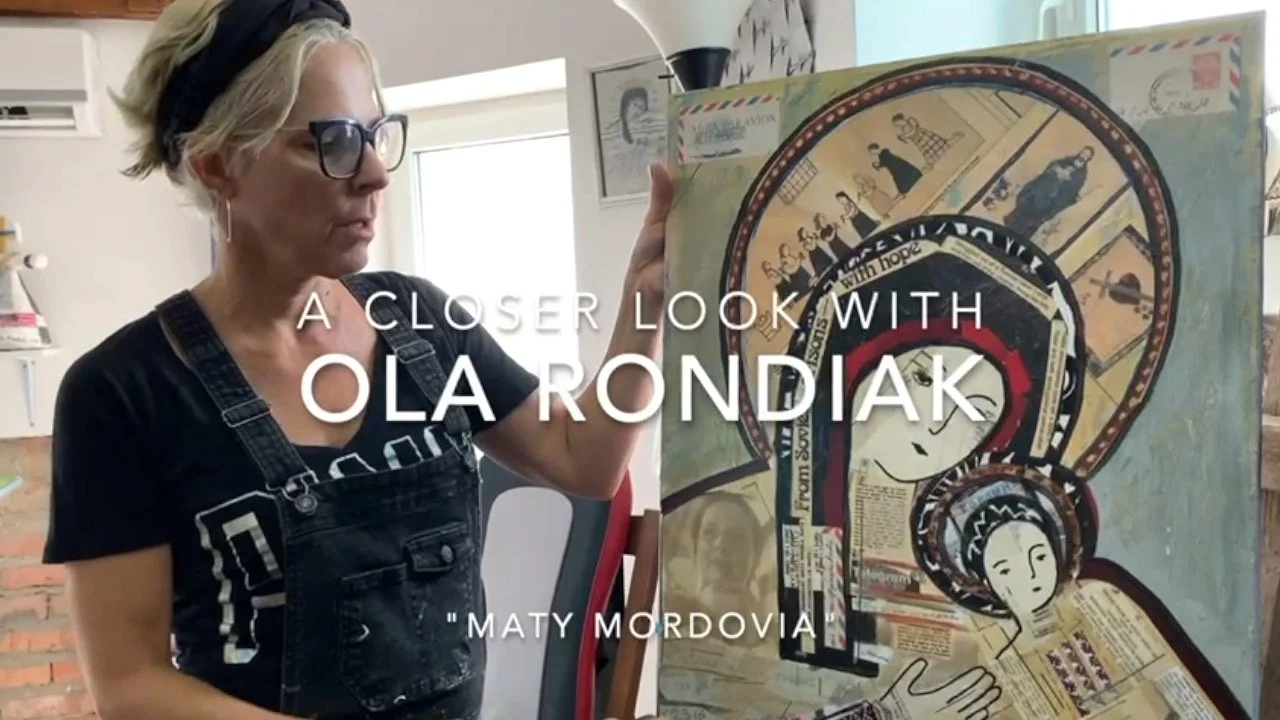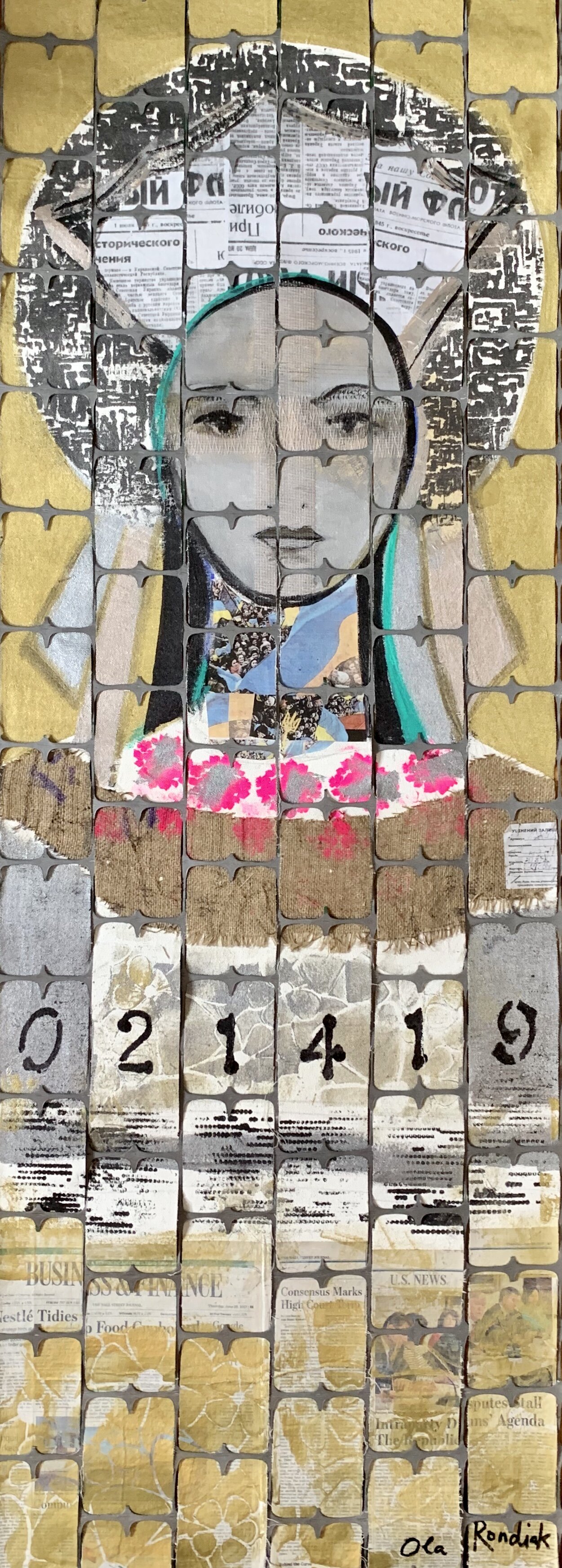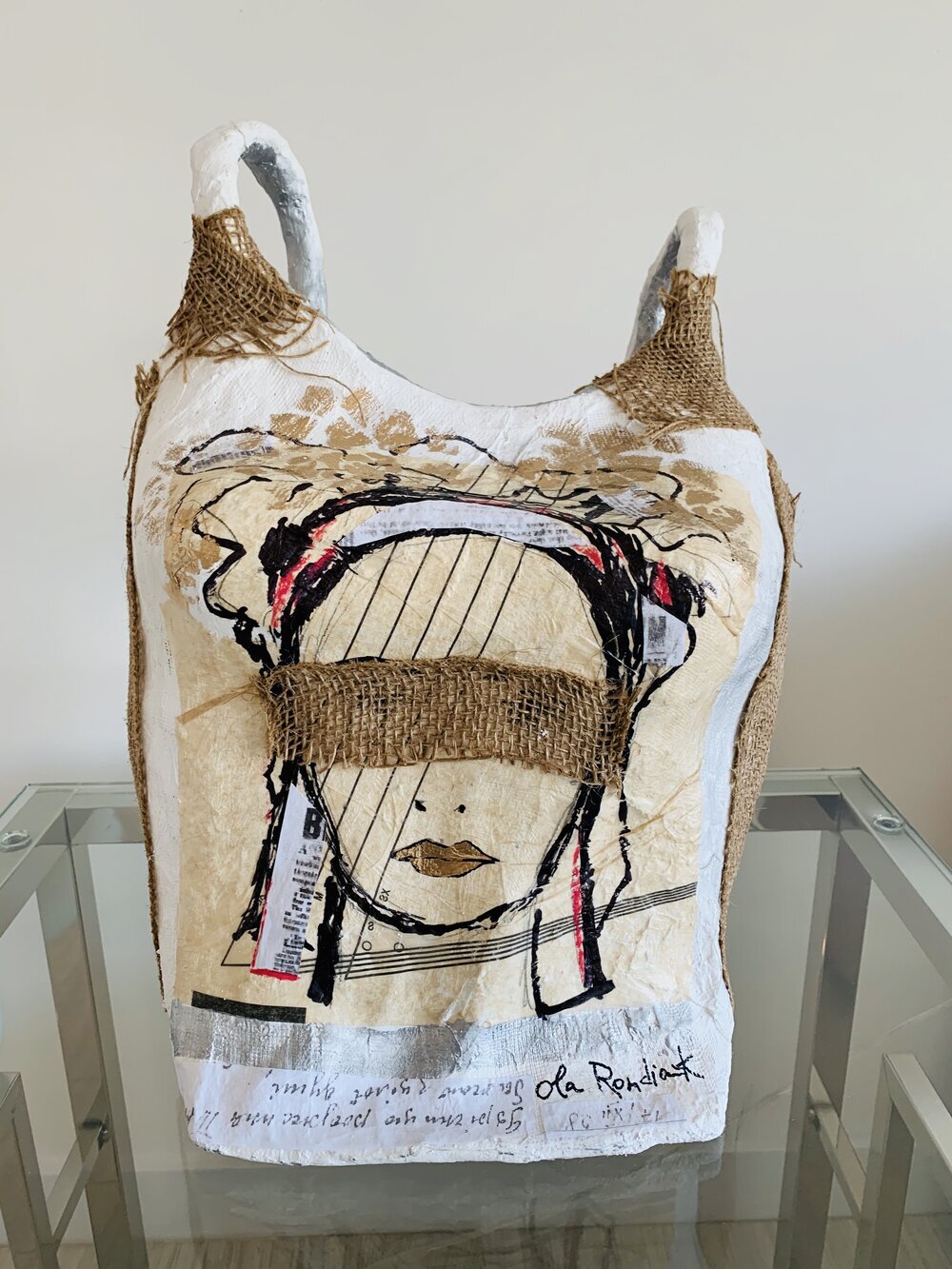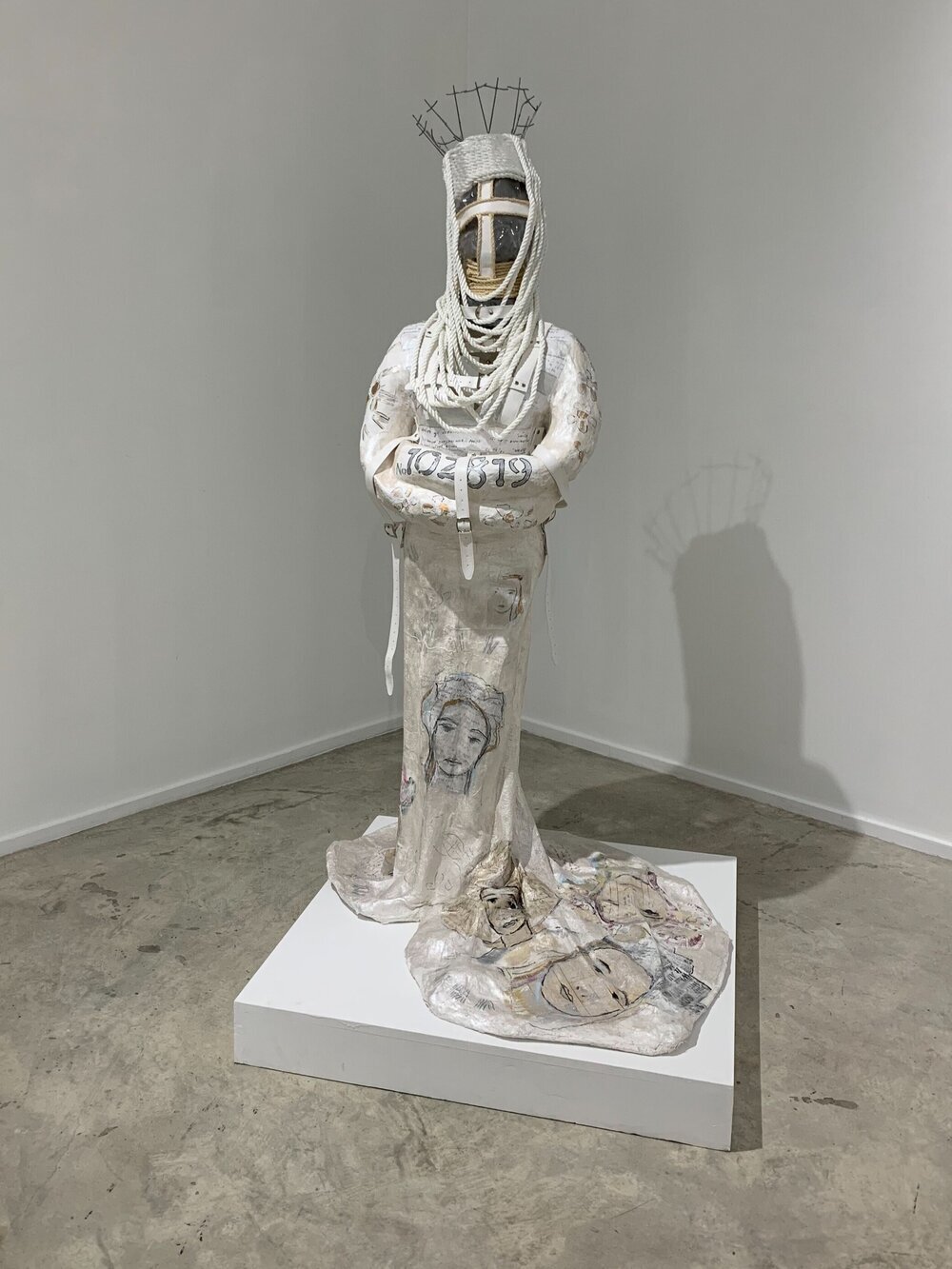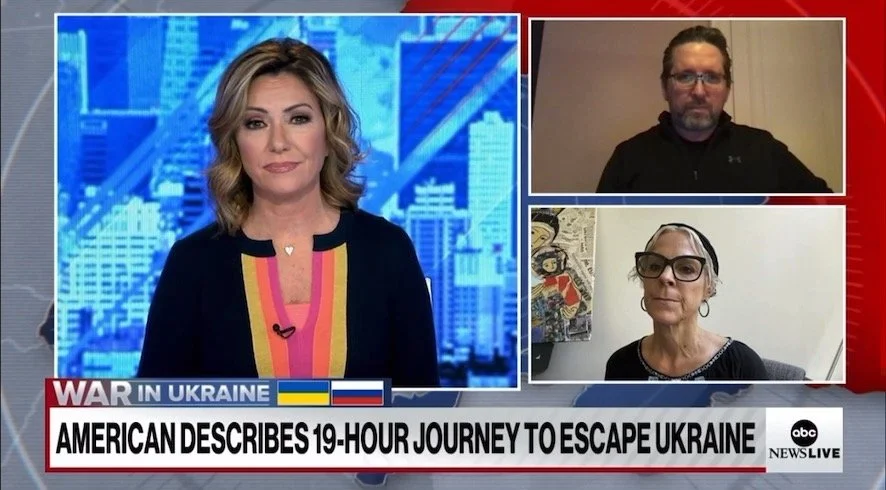Past Exhibition
Mar 2 - Apr 17, 2022
Ola Rondiak
MIND OVER MATTER - REDUX
Two years ago, for the Metroquadro Miami art gallery, Ola Rondiak launched an investigation into her own visual language that ascribed the realities of the past, present, and hopes for the future of Ukraine. Now, with her country on the cusp of assault, Rondiak culled from her arsenal of set-aside collages and multilayered sculptures and harvested then into objects of new meaning that lay witness to the resurrection of aggression and hegemony by the Russian oligarchy. Worth repeating, if words over time serve as the pages to Ukraine’s ever evolving story, then Ola Rondiak’s exhibition Mind Over Matter - Redux is its scribe.
Upon close inspection, the viewer will find the images in this online exhibition photographed unlike the gold standard of finely tuned cropping and lighting. Rather, they are displayed in a raw state, in situ, at a studio far from the artist’s home suggesting the artist’s vigorous exilic response to the crisis abroad.
In its first iteration, Rondiak invoked significant family and national events to underscore the theme of the exhibition arraying her work with the script of rich historical references to imprint a sense of emotion, memory, or perception. Each piece enshrined a historical or cultural reference. Her family lived through the cataclysmic events of WWII and Stalin’s Iron Curtain. The Orange Revolution in 2004 and the Revolution of Dignity in 2014 shaped her sense of the physical world. Now, in 2022, with family history, current events, and trauma resurfaced, the legacy of Ukrainian crafts continues to find fertile ground with which to inform Rondiak’s aesthetic and process.
Rondiak’s work interweaves those traditional Ukrainian motifs with a unique vision for how she perceives the world. If art is used as a window to see the soul, as George Bernard Shaw once said, then her work reveals the soul of Ukraine housed in the framework of angst and loss. Yet her work is also about the fortitude of the human psyche to overcome hardship, to connect with our identity through personal histories, to unite with our communities, to find freedom from within. Her work is an invitation to use one’s Mind Over Matter, while at the same time shows us that we are not alone in the world. In this sense, her work strikes a delicate balance between invention and psychological intervention and underscores the importance that art serves as a barometer of truth in a time when truth can be controlled and questioned.
To punctuate the focus of Mind over Matter-Redux, the artist has employed her consistent practice of layering a diversity of materials in both three and two-dimensional form. She uses plaster of Paris, found objects, paint, gold leaf, wire, and rope, to produce sculptures, paintings, and wearable art. In the first days of protests against the Russian invasion of Ukraine last week, Rondiak took to the streets of New York with one of her Plaster of Paris motankas and an unfinished drawing and asked people to sign them. Emblazoned with hundreds of inscriptions, the motanka and drawing stand as unifying symbols of healing and hope. Inspired by the ancient Ukrainian rag doll, the female forms in both pieces symbolize the strength and grit of the Ukrainian people. When the war broke out in 2004 in Ukraine, Rondiak began creating the sculptures. When mixed with water the plaster thickens and quickly hardens. The symbolic material substance designed to hold broken bones together now represent healing. As such, the work invites viewers to reflect on the tenacity of the human psyche to overcome hardship, to relinquish the trans-generational pain, and begin life anew. As Rondiak’s grandfather once told her “no one can take control over our minds.”
Four Female Portraits
Rondiak understands that memorializing devastating events can, indeed, humanize them especially if illuminated through the familiar image of the eastern Theotokos (Mother of God). Growing up in a Ukrainian family and then living in Ukraine for many years ensured Rondiak’s exposure to the iconography on display in orthodox churches. The early church cultivated the Mother of God icon imbuing it with Divine presence and reality to serve as a potent aid to devotion. Ennobled by her exalted status and divine wisdom, the church looked to the Mother of God as a representative of redemption. Herein lies the power of Ola Rondiak’s imagery: she adopts a highly familiar icon and refabricates it into her own visual vocabulary. The Mother of God is now a potent image representing Every Woman Faced with Oppression or Loss. The austere imagery of the female portrait, like her Byzantine antecedents, face frontally predicated against a flat background; instead of a gold halo, the heads are crowned with the traditional Ukrainian vinok. The eyes and mouth are downcast or angled, evoking sorrow. Like the Byzantine artists, Rondiak infuses her paintings with strong, bold lines to direct eye movement and generate maximum emotional impact. Moreover, the decorative patterning on the four portraits recall Ukrainian folklore to evoke national pride, unity, memory, and nostalgia. As such, the artist sets the framework for restorative contemplation.
Rondiak’s work Female Icon with Black Face relates to the use of the cloak, or dress, as common article now reimagined as a symbol of strength amid adversity. Placing the female form directly in the center of the composition not only lends immediacy for the viewer, but the painting also examines the forces of the mind, identity, evolution, and female place in society and history.
Out of USSR
Originally used as a form of restraint, Rondiak reinvents her own series of straitjackets using canvas, fabricating her own vinyl straps, and stitched with a meticulous detail of beadwork, embroidery, paint, and metal wire for a headdress. In taking an object once designed to limit movement—to control both the body and the mind—Rondiak has transformed the straitjacket imbuing it with the determination of the human psyche to overcome hardship. In perching the wire headdress atop the form, the artist conjures a divine presence and power locating freedom not just in community but within one’s inner resolve despite external circumstances underpinning Mind Over Matter.
The Two Female Portraits wear the traditional Ukrainian headdress, the vinok, a headband festooned with a crown of flowers. Stitched into history, the vinok has long been associated with purity, marriage, female power, and now stands as a symbol of nationalistic pride and, in a double entendre, for peace to grow.
Layered with an assortment of materials celebrating Ukraine’s rich history, Rondiak’s works are visual subjunctives that evince eternal desires. Now, with the pangs of war raging, they convey the yearning for that which is worth fighting: freedom. The straitjacket was eventually decommissioned after the Enlightenment and finding more therapeutic and holistic measures offered to assuage patients’ physical outbursts. Rondiak’s straitjackets, like the rest of her oeuvre, harvested into a contemporary and captivating symbol of freedom, lend a far-reaching, visceral portal for viewers to consider what Mind Over Matter means for them; and by engaging the work, in some way, redeem one’s own narrative with expectant longing. It truly is a matter of mind over matter.
Female Icon with Black Face, 2022
Four Female Portraits, 2022
Motanka and Drawing with signatures, 2022
Straitjacket with Wire Headress, 2022
Two Female Portraits, 2022
Together We Stand Acrylic collage on canvas 39.4 x 47.24 in
Vinok 64 Acrylic collage w spray paint on canvas 27.55 x 35.43 in
021419 Mixed media 70.86 x 23.62 in
Captured Acrylic collage on canvas 60 x 36 in
Still Free Acrylic Collage on Canvas 74.8 x 62.99 in
Where to? Tank, Paper mache, fabric, acrylic collage, plaster of Paris, burlap, gold liquid gilding, 16 x 13 in
Homework Tank, Paper mache, fabric, plaster of Paris, acrylic collage, liquid gilding 20 x 16 x 11 in
Trypillian Rope, Paper mache, wires, foam, plaster of paris, rope 54 H x 31 W x 23 D in
Identity Version 2, 2018, Acrylic Collage on Canvas, 45 x 55 in
021420, Mixed media
Fragile Tank, Paper mache, fabric, plaster of Paris, acrylic collage, gold leaf 14 x 13 x 9 in
102819, Paper mache, fabric, plaster of paris, 72 H x 40 W x 30 D
Styrofoam, fiberglass, resin, auto paint 34.25 x 23.22 x 14.17 in
Primal, Mixed media
No Trespassing Dress, 36 H x 19 W x 10 D in
Contact us
If you have any inquiries or comments, please send us a message using the contact form or email us at info@johnwilliamgallery.com
















